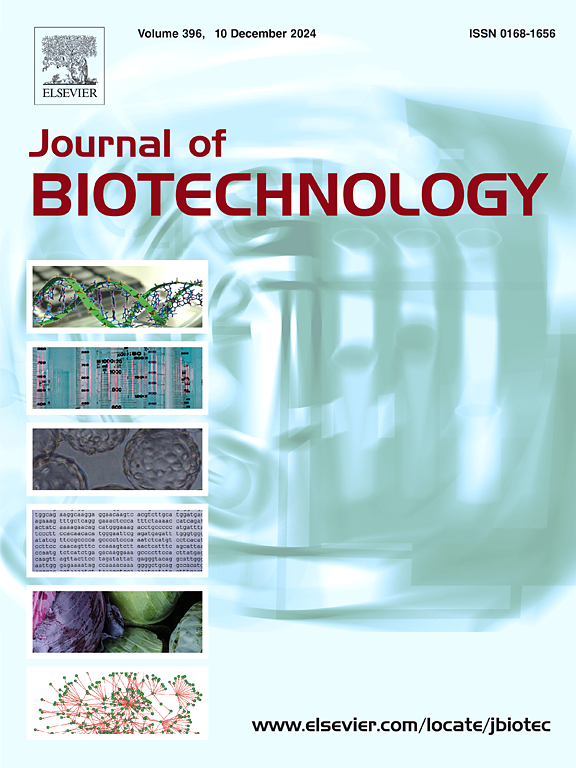3-hydroxypropionic acid production from Brewer’s spent grain with an engineered Issatchenkia orientalis
IF 3.9
2区 生物学
Q2 BIOTECHNOLOGY & APPLIED MICROBIOLOGY
引用次数: 0
Abstract
3-Hydroxypropionic acid (3-HP) is a versatile platform chemical with wide-ranging industrial applications. This study presents a proof-of-concept approach for producing 3-HP from brewer’s spent grain (BSG) using a novel one-pot CaO pretreatment method and an engineered, acid-tolerant Issatchenkia orientalis IoDY01H strain. The effects of acid type for pH adjusting of pretreated slurry, nitrogen supplementation, NaHCO3 addition, and BSG deproteinization were evaluated. Results showed that using pure glucose and xylose as carbon sources, yeast extract-peptone (YPDX) medium enhanced 3-HP titers by 13.3 % compared to synthetic complete (SCDX) medium. NaHCO3 supplementation further boosted the 3-HP titer to 7.8 g/L, representing a 7.8 % increase over YPDX alone. In BSG hydrolysates, pH adjustment with H2SO4 resulted in higher 3-HP production (7.4 g/L) compared to H3PO4 (6.8 g/L). Moreover, supplementation with NaHCO3 further increased the 3-HP titer to 7.7 g/L, while yeast extract-peptone reduced the 3-HP titer to 6.7 g/L by diverting flux toward strain growth and ethanol formation. Notably, deproteinization of BSG improved xylose recovery and achieved the highest 3-HP titer of 8.7 g/L without nitrogen supplementation. This work provides insights into integrating one-pot pretreatment and hydrolysis and robust fermentation without external nitrogen to produce value-added products from biomass feedstocks.
从布鲁尔的废谷物中提取3-羟基丙酸
3-羟基丙酸(3-HP)是一种具有广泛工业应用的多功能平台化学品。本研究提出了一种概念验证方法,利用一种新的单锅CaO预处理方法和一种工程耐酸Issatchenkia orientalis IoDY01H菌株,从啤酒废谷物(BSG)中生产3-HP。考察了不同酸型对预处理浆pH调节、补氮、NaHCO3和BSG脱蛋白的影响。结果表明,以纯葡萄糖和木糖为碳源,酵母提取物-蛋白胨(YPDX)培养基与合成完全物(SCDX)培养基相比,3-HP滴度提高了13.3 %。NaHCO3的补充进一步将3-HP滴度提高到7.8 g/L,比单独使用YPDX提高了7.8 %。在BSG水解物中,与H3PO4(6.8 g/L)相比,H2SO4调节pH可产生更高的3-HP产量(7.4 g/L)。此外,添加NaHCO3进一步将3-HP滴度提高到7.7 g/L,而酵母提取物-蛋白胨通过将通量转向菌株生长和乙醇生成,将3-HP滴度降低到6.7 g/L。值得注意的是,在不添加氮的情况下,BSG脱蛋白提高了木糖的回收率,3-HP滴度最高,为8.7 g/L。这项工作为整合一锅预处理和水解以及无外部氮的强劲发酵提供了见解,以从生物质原料中生产增值产品。
本文章由计算机程序翻译,如有差异,请以英文原文为准。
求助全文
约1分钟内获得全文
求助全文
来源期刊

Journal of biotechnology
工程技术-生物工程与应用微生物
CiteScore
8.90
自引率
2.40%
发文量
190
审稿时长
45 days
期刊介绍:
The Journal of Biotechnology has an open access mirror journal, the Journal of Biotechnology: X, sharing the same aims and scope, editorial team, submission system and rigorous peer review.
The Journal provides a medium for the rapid publication of both full-length articles and short communications on novel and innovative aspects of biotechnology. The Journal will accept papers ranging from genetic or molecular biological positions to those covering biochemical, chemical or bioprocess engineering aspects as well as computer application of new software concepts, provided that in each case the material is directly relevant to biotechnological systems. Papers presenting information of a multidisciplinary nature that would not be suitable for publication in a journal devoted to a single discipline, are particularly welcome.
 求助内容:
求助内容: 应助结果提醒方式:
应助结果提醒方式:


